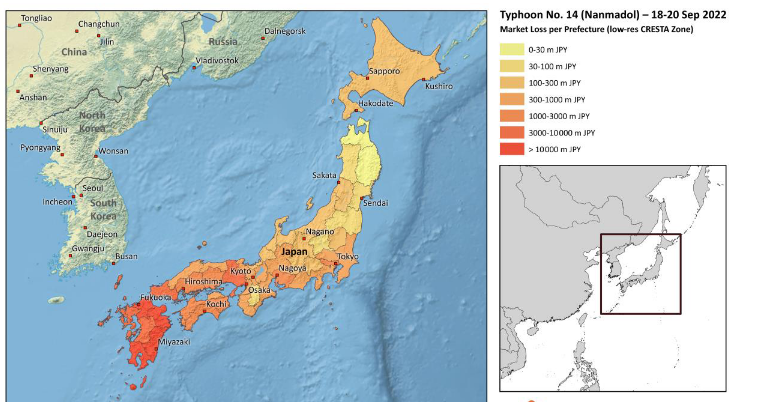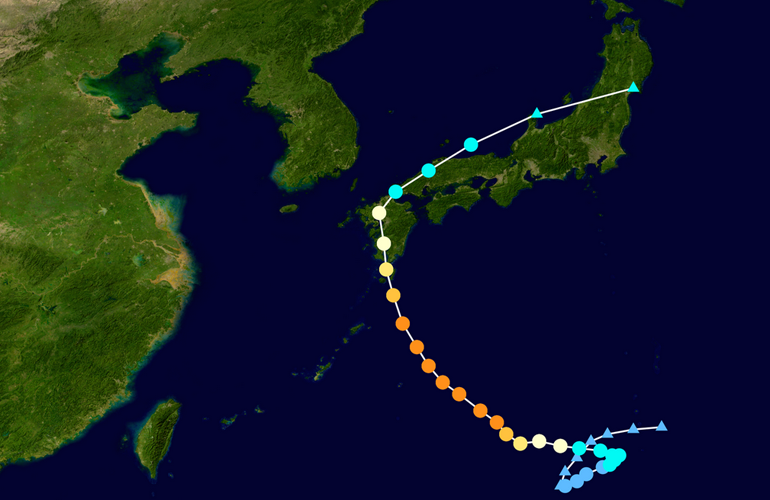
PERILS, the provider industry-wide catastrophe insurance data, disclosed its third industry loss estimate for Typhoon No. 14, also known as Nanmadol, which affected the islands of Kyushu and Shikoku in southern Japan and the western and central regions of Honshu from 18 to 20 September 2022.
According to PERILS, the total industry event loss figure, based on detailed loss data collected from the majority of the affected insurers, is JPY 129.6bn (~$1 bn).
This figure compares to PERILS’ previous loss estimates of JPY 119.7bn, released on 20 December (three months after the event), and JPY 113.5bn, released on 1 November (six weeks after the event).
In accordance with the PERILS coverage definition for Japan, this number encompasses only property losses sustained by the Japanese non-life insurance industry and does not include losses sustained by the cooperatives insurance industry (Kyosai).
Typhoon Nanmadol loss data can be applied to multiple use cases, including enabling the correlation analysis of maximum gust speed and damage degrees.
Lukas Wissler, Product Manager at PERILS
This third report provides a detailed breakdown of property losses by prefecture (low-res CRESTA zone) with the data further divided into Property lines of business.
It is complemented with information on damage degrees which show the damage as a percentage of sums insured, as well as wind-gust and rainfall data.
Together with the PERILS industry exposure database, this information can be used to calibrate damageability functions in probabilistic Cat models for Wind Japan.

In line with the PERILS reporting schedule, an updated estimate of the market loss from Typhoon Nanmadol will be made available on 20 September 2023, twelve months after the event end date.
Typhoon Nanmadol was the 14th named storm in the 2022 Western North Pacific typhoon season. It made landfall on 18 September near the city of Kagoshima on southern Kyushu Island.
The typhoon brought strong winds and extreme rainfall leading to flooding and landslides.
The majority of the losses occurred on the island of Kyushu which incurred 75% of the total industry loss.
The overall size of the industry loss was, however, not exceptional for the Japanese non-life insurance industry, despite gusts of up to 183km/h and rainfall of up to 904mm within a 72-hour period.
The manageable loss impact of Typhoon Nanmadol demonstrates the high level of preparedness across Kyushu Island for extreme weather events.
PERILS ability to deliver such a detailed industry loss footprint has only been possible due to the strong support of the Japanese P&C insurance industry, for which we would like to thank them sincerely.
This third loss report on Typhoon Nanmadol is an important milestone for the Japan non-life insurance industry. This is the first time that property LOB-level industry loss information per prefecture has been released for a typhoon event.
Takashi Goda, Senior Advisor for PERILS in Japan
This provides valuable insight into the vulnerability of insured property assets in Japan. In our view, there is clear value in being able to calibrate models with ground-truth data as it supports a more robust assessment of Japanese typhoon risk.

Typhoon Nanmadol, known in the Philippines as Super Typhoon Josie, was a powerful tropical cyclone that impacted Japan.
The fourteenth named storm, seventh typhoon, and second super typhoon of the 2022 Pacific typhoon season, Nanmadol originated from a disturbance to the east of Iwo Jima which the Joint Typhoon Warning Center (JTWC) designated as a tropical depression on September 12. Later that same day, upon attaining tropical storm strength, it was named Nanmadol by the Japan Meteorological Agency (JMA).
The storm gradually became better organized, with its sustained winds reaching typhoon strength two days later. It then underwent rapid intensification, with its wind speed increasing by 45 km/h (30 mph). Nanmadol peaked with winds of 195 km/h (120 mph) and a central pressure of 910 mbar (26.87 inHg) on September 17, and also briefly entered the Philippine Area of Responsibility, where it received the name Josie.
Following peak intensity, the storm began an eyewall replacement cycle and tracked north towards Japan, where it made landfall on Southern Kyushu on September 18. Later, Nanmadol became a severe tropical storm on September 19, before transitioning into an extratropical low early the next day.





